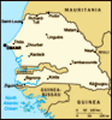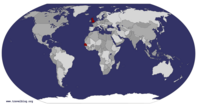Advertisement
Published: August 27th 2012
Not such a mini adventure when I think about it because we travelled the length of Senegal in a week. We set off last Sunday at the crack of dawn ready to face the Banjul ferry. In typical fashion we hung around waiting for the 7 o’clock ferry till about 9 o’clock. One was sitting in the dock but they decided that one was too slow so they would wait for the other to come over from the north side. That one was ridiculously slow anyway, God knows what the other one was like, taking 2 hours to travel the 5km distance from Banjul to Barra on the north bank of the river. After a quick taxi ride we finally got to the border and this time, passport at the ready, I managed to cross over into Senegal (see blog from 1
stJanuary for what happened last time I tried). We were taking a sept plaz to Dakar, the capital of Senegal. You have to wait for all seven seats in the car to be taken before the driver will set off so, as the first passengers to arrive for our car, we had another long wait. Finally, after getting up at
half five in the morning by 11 o’clock we were on our way properly to Dakar.
And about four hours later we got there. Dakar felt huge after being in Gambia for so long. It’s a proper city that sprawls out. It has real roads, practically motorways, leading into the city which contrasts to the markets, abattoir’s and mudding paths that run alongside it. After arriving at our hotel, exhausted and going out to find a quick bite to eat before collapsing into bed I decided that Dakar made me want to go to France. It kind of feels like France because everyone speaks French (if they’re not speaking Wolof); the signs are all in French and people drive around looking trendy on scooters or in shiny new Renaults, even some of the taxis are quite shiny. More like the back streets of Paris mind where the street cleaners have gone on strike and no maintenance has been carried out on any of the buildings in about twenty odd years. Still, you can get good proper coffee and a pain au chocolat on pretty much every street corner so you can sort of pretend you’re in Paris.
I think I got a strange view of the city though having arrived during the Koriteh festivals that celebrate the end of Ramadan. I think it was a bit like turning up in the middle of London on Christmas day or at Canary Wharf on a Saturday afternoon. It was a bit of a ghost town as everyone clears out of town to visit their families.
On our first full day we visited the Ille de Goree, an island just off the coast of the city which is famed because it was where many slaves were transported to before they were shipped off around the world. The buildings date back from the time when it was a French colony so it really does feel like a Mediterranean village with terracotta and sunny yellow buildings, wrought iron balconies and palm tree gardens. So if you can remain in denial about why these buildings were there in the first place the island is beautiful. We managed this state of denial quite nicely because all the museums telling you about it all were closed because it was a Monday. All that was left to do was find a restaurant tucked
away with a good view of the sea, to have a drink and a nice lunch. We enjoyed the ferry ride over there as much as anything. It was supersonic compared to that Banjul ferry!
On our second day we visited Lac rose, a lake about an hour or so outside of Dakar that is famed for it’s salt. I say an hour or so, our taxi driver took us on a magical mystery tour to get there through the suburbs of Dakar. I’ve never seen so many half built buildings. For miles and miles there were houses that were not much more than concrete boxes seemingly randomly spaced out with only about one in ten of them actually finished. I imagine this shows the slow and gradual development of Dakar. I wonder if in ten years time these buildings might actually be finished and Dakar will eventually get to be about the size of London. Anyway, Lac rose, when we finally got there was beautiful. The salt content in the lake is so high that when the sun shines on it it looks pink. The water is almost thick making it difficult to paddle in. The
little boat ride we took was half an hour and we barely got anywhere. This might have been due to the natural state of the lake or the fact that our boatman seemed more interested in having a good chat to Lamin about the state of politics in Gambia than actually getting us anywhere.
The next day we had another early start to travel to Saint Louis, a town on a small island off the very northern coast of Senegal. If Dakar made me want to travel to Paris, Saint Loius made me want to go to Venice. There are two islands running parallel to each other off the coast linked together by bridges so there's water all around. The water’s edge in between them was full of fishing boats which looked like giant gondolas. All the fishermen again were enjoying their days off for Koriteh. The island of Saint Louis was the first French colony in Africa so it’s full of more French colonial buildings in various states of restoration or disrepair. We spent most of our time either lying next to the pool in our hotel which was very nice indeed and unbelievably cheap or

 Tapesries at Thies
Tapesries at Thies
You weren't allowed to take pictures of the tapestries in the gallery but this was a mural of one on the outside wall.wandering around the streets on the island, appreciating how old the buildings are considering there’s probable few buildings in Gambia that are more than 30 years old before they fall down. The bridge from the mainland was built in 1897 and rotates for ships to pass through. Not that impressive by European standards but the fact that that is here is Africa from so long ago is amazing to me. The other amazement was the taxis, the local ones that is. I though Gambia was where cars go to die but I was wrong, they come to St Louis. Lamin was goggle eyes at the fact that they were still moving. We made an effort to find the worst one and take a ride in it. It all started out quite funny and we were wanted to take our picture next to it until half way there were remembered that this was the drivers actual car and the way he made a living. It was a little bit sad but really this guy deserves a medal for being the best mechanic in the world to keep that thing on the road.
Instead of travelling back to Gambia
via Dakar we went by the town of Thies. This is a small town not too far from Dakar that apparently grew because two railway lines cross at this point. Yes Senegal has a railway! I was really surprised! I think Thies might be really nice. It’s got a small town feel to it, with some nice restaurants and lovely tree lined streets, but when we were there the rain came, so it was wet, soggy and muddy and I got pooed on twice by birds. Our walk around therefore did not last long. We did manage to visit the Manufactures Sénégalaise des Arts Décoratifs where they make the famous Thies tapestries, not that I’d ever heard of them. They were beautiful though and apparently our own Queen Lizzie has one hanging in Buckingham Palace which I’ll be keeping an eye out for the next time I go and visit her.
So we had a great time in Senegal. It did feel quite different to Gambia although I can’t put my finger on why. It felt more developed and just a lot bigger, though that just might be because I know it is from the map. The
towns felt more substantial where the buildings were actually finished. However there seemed to be more poverty. At every garage and market there were hoards of small boys dressed in rags with little pots begging for money. Even Lamin was shocked and couldn’t understand how their families could let them out to do it. The week was a great experience but it’s nice to be back in familiar old Gambia. We were unlucky enough to arrive back at Setsetal (clean up Saturday) where no one is allowed to travel meaning no taxies. We therefore crossed the border on a horse and cart which seemed quite a fitting way to arrive back.
Advertisement
Tot: 0.107s; Tpl: 0.013s; cc: 6; qc: 44; dbt: 0.0691s; 1; m:domysql w:travelblog (10.17.0.13); sld: 1;
; mem: 1.2mb

















